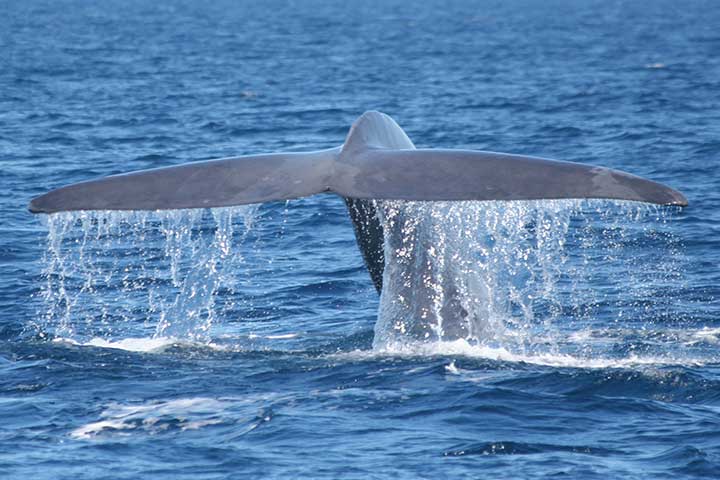Blue Whale
Blue Whale Facts
| Size | Up to 98 ft (33.52 m) |
| Speed | Up to 18 mph (30 km/h) |
| Weight | Up to 200 tons |
| Lifespan | 80-90 years |
| Food | Plankton, krill, small fish |
| Predators | Orcas |
| Habitat | Global oceans |
| Order | Whales |
| Order | Baleen Whales |
| Family | Rorquals |
| Scientific name | Balaenoptera musculus |
| Characteristics | Large whale with baleen plates |
Main Characteristics
The blue whale is the largest and heaviest animal on earth. It belongs to the baleen whale family – along with the humpback, fin, gray, right whale, bowhead and minke whales. It feeds mainly on krill and plankton.
Habitat
Blue whales live in all oceans of the world. They rarely come near coasts, but stay mainly in the high seas.

Anatomy and Appearance
Size and Weight
A blue whale weighs up to 200 tons and can be over 98 feet (30 meters) long. It is always difficult to get an idea of big dimensions. So here are some comparisons: The weight of one blue whale equals that of four large brontosauruses, 23 elephants, 230 cows or 1,800 humans. Its tongue weighs as much as a young elephant. The heart of an adult blue whale is the size of a golf cart.
Fins
The dorsal fin is only about 18-18 inches (33-45 cm) in height, while it can be up to 70 inches (180 m) in the orca. The caudal fin (= fluke) has a characteristic notch in the middle and is 20-23 feet (6-7 meters) wide. The flippers are very thin and elongated.
Baleens
Instead of teeth, the blue whale has 300-400 thin, black horn plates in its upper jaw. They are called baleens. The blue whale doesn't need them for cutting or chewing, but for filtering water. The baleens have feather-like fibers. They work like a sieve, letting water through but not the krill or plankton. The baleens are about 20-40 inches (50-100 cm) long.
How to Identify a Blue Whale
You can catch a glimpse of a blue whale when it comes up for air. Yet, mostly you can only see a small part of its back. Marine researchers identify them by the height of the fountain that can be seen when they surface. The fountain is produced by the air that is pushed out of their blowhole. It is up to 30-40 feet (9-12 meters) high. With one exhalation it could fill 2,000 balloons.

Life Style
Blue whales are mostly solitary animals. They meet rather by chance when they feed in areas with lots of plankton.
Diet
Blue whales feed primarily on plankton. Plankton is the name for a diverse collection of tiny creatures that live in water. They're unable to propel themselves, so they just drift through the sea. A single plankton is called a plankter. Blue whales also eat krill. These are small shrimp-shaped crustaceans with a length of up to one inch (1-2 cm). Blue whales eat four to eight tons of plankton, krill and small fish every day.
How Do Blue Whales Eat Their Food?
Blue whales search the ocean for large, dense swarms of krill and plankton, because they prefer to eat a lot of food in a short amount of time. When they find a swarm, they swim towards it at high speed and open up their mouths as wide as possible to catch it. Then it closes its mouth and pushes the water out through its baleen. The swarm stays in the mouth and can be swallowed.

Behavior
Migration
Blue whales migrate to warmer or colder waters depending on the season. In the warmer, subtropical seas they meet to reproduce. For feeding they head to colder seas, for example the Arctic Ocean and the Southern Ocean.
Abilities and Senses
Sense of Sight
Blue whales can't see very well. Their eyes aren't much bigger than a grapefruit. They rely on their excellent sense of hearing. It is their most important sense. It is said that they can hear sounds at distances of up to 994 miles (1,600 km).
Singing
Blue whales do not sing as beautifully as humpback whales do. They produce very deep tones that can get as loud as 188 decibels (louder than an airplane). Because water transports sound very well, they can even be heard 500 miles (800 km) away.
Diving
Most of the time, blue whales dive to a depth of just 330 feet (100 meters) to forage for food. The deepest recorded depth was 1,000 feet (315 meters). Blue whales surface to breathe every two minutes. Sometimes it is between three and ten minutes, in rare cases up to 15 minutes. When blue whales dive, their heart rate slows to two beats per minute. This allows them to stay underwater longer.
Heartbeat
Even when a blue whale exerts itself physically, its heart only beats up to 37 times per minute. With us humans it can rise well over 100 times per minute during exertion.

Enemies and Threats
Blue whales have few natural enemies. Sick, injured or young animals are sometimes preyed upon by large sharks and orcas. The greatest threat is man. Since the beginning of the 20th century, whalers have killed more than 350,000 animals. Today, maritime traffic is also a threat. The noise of the ships disturbs the animals. They also collide with them and are fatally injured. Pesticides and mercury in the water don't make life easier for the animals. Today, according to the IUCN, there are only 5,000-15,000 animals left (data from 2018; as of March 2023). The blue whale is considered an endangered species.
Reproduction
Blue whales swim to warmer waters to mate. A calf is born after eleven months. At the time of birth, it already weighs two tons. That's as much as two small cars. It is nursed for six to seven months until it is over 40 feet (12 meters) long. Then it can take care of itself.
Fun Facts
The blue whale is not the longest animal. Instead, it is a slim giant ribbon worm. It can grow 180 feet (55 meters) long.

Animals in the Same Biome:
- Albatross
- Atlantic Puffin
- Fin Whale
- Sharks
- Sperm Whale
- Loggerhead Sea Turtle
Featured Posts:
- Watch Now on animalfunfacts.net:
 Video: All About Mammals
Video: All About Mammals





















